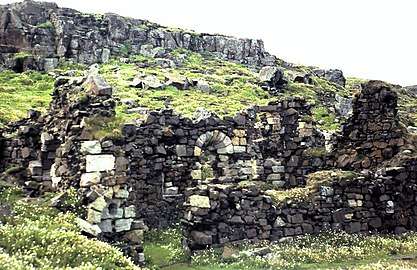Adrian of May
Saint Adrian of May (sometimes given as "Magridin") (d. 875) was a martyr-saint of ancient Scotland, whose cult became popular in the 14th century. He is commemorated on 3 December. He may have been a bishop of Saint Andrews.[1]
Life and martyrdom

Little is known of the life of this Scottish saint and martyr. He is held by some to have been an Irish monk and bishop, with the Gaelic name of Ethernan,[2] who, though he might have been the Bishop of St. Andrews, was drawn to remote locations and had built a series of monasteries and hermitages on the Isle of May (which is five miles out to sea in the Firth of Forth) and along the coast of Fife. Later he withdrew from his see of St. Andrews due to the invading Danes and took refuge on the island.
What is known is that about A.D. 875, marauding Vikings invaded the island of May. They then slaughtered the entire population of the monastery, traditionally numbered at six thousand six hundred.[3] The island was then abandoned for centuries.
In 1145, King David I of Scotland gave the island to Reading Abbey in Berkshire, England, at which point, the island again became a religious centre. The English monks started the erection of a small monastery dedicated to St. Mary the Virgin, with a shrine to St. Ethernan.[4]
Veneration
Early building was hampered due to raiding parties of Scandinavians who had settled in Orkney. The privations and isolation of the location finally led the monks to transfer the island in some manner to the Bishop of St. Andrews in A.D. 1288. Shortly thereafter, in 1296, war broke out between the Kingdoms of Scotland and England over territorial claims along the border between the two realms. This was paralleled in a legal fight between the abbey and the bishop over who actually owned the island. Initially, the abbey was confirmed as the lawful owner. This, however, was overturned in 1313 and the island was declared a part of the diocese. In consequence of this, English forces attacked the island and destroyed the monastery. After the conclusion of hostilities, the island became an important symbol of national pride, and pilgrimages to May became a common feature of religious life for the Scottish people.[5]
Post-Reformation
When the Scottish Reformation took hold in the 16th century, public devotion to the saints—and thus pilgrimages to the site—came to a halt and the Protestant bishop of St. Andrews soon decided to sell the island into private ownership. Slowly the island sank into ruin, with most of the surviving monastic buildings disappearing. Recently the island has become the site of archaeological excavations seeking the remains of the original monastic community which died at the hands of the Vikings.[2]
References
- "Saint Adrian of May". CatholicSaints.Info. Retrieved 7 February 2019.
- Keys, David. "Archaeology: Secrets of St. Adrian's Isle", The Independent, 4 August 1994
- http://www.bartleby.com/210/3/043.html
- Keys. "Archaeology".
- Keys. "Archaeology".